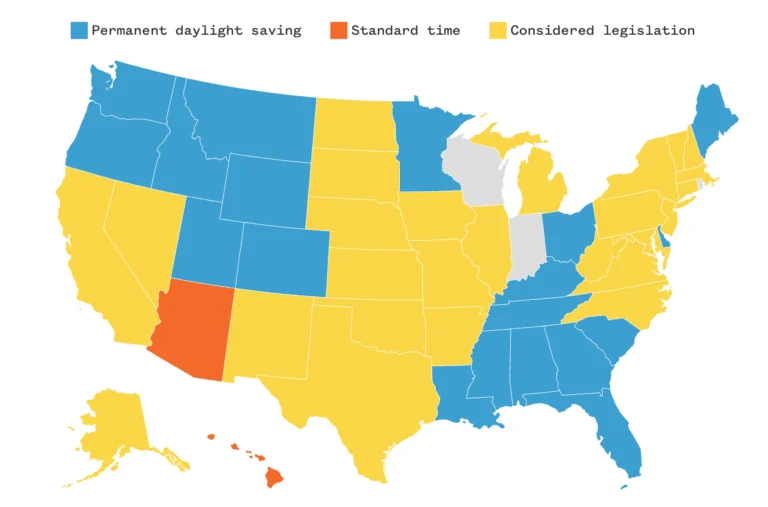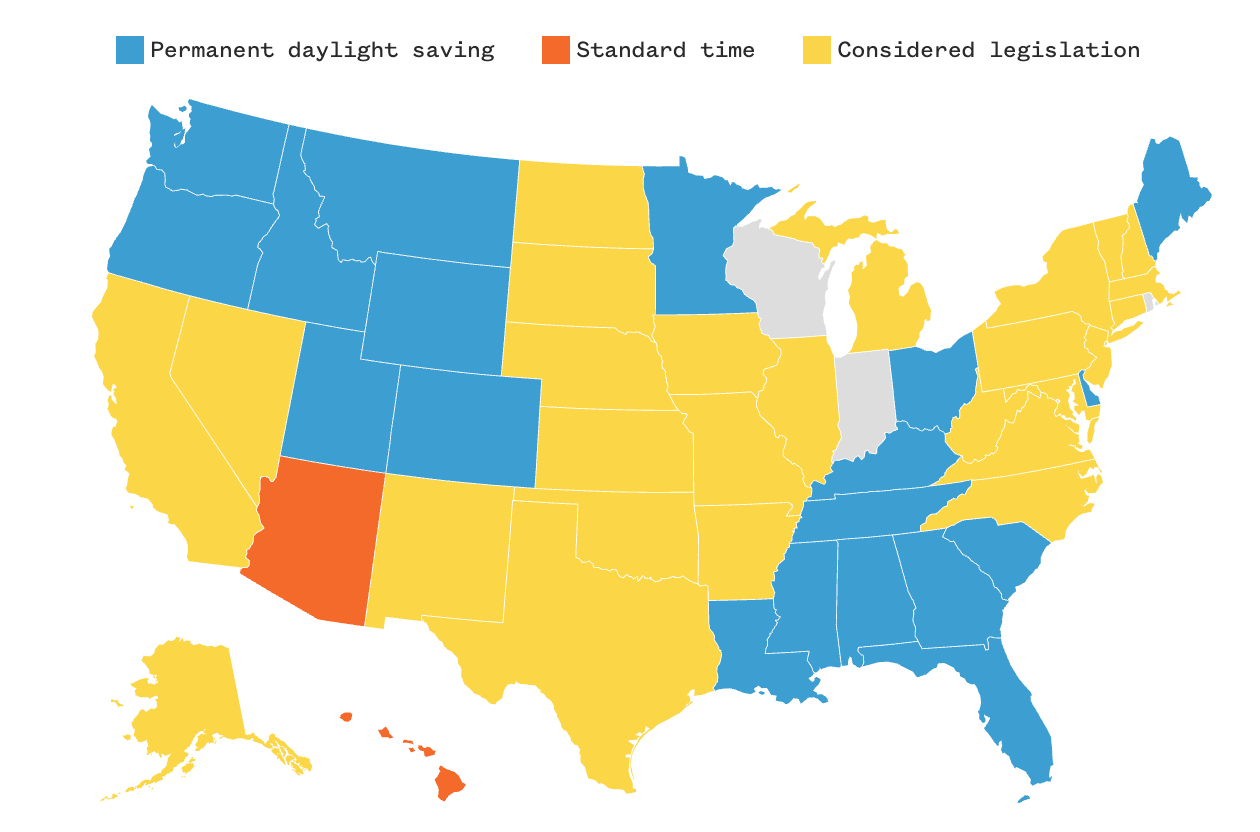Changing the clocks twice a year might seem like a small adjustment, but it has a real impact on our daily lives. In the United States, daylight saving time has been practiced since World War I. While it often sparks confusion and debate, daylight saving time (DST) is still observed in most states in the US.
In this article, we explore the reasons why daylight saving time is still practiced in the US, despite its effects on health, productivity, and daily routines. Does it still make sense to maintain this system?

Photo by NBC News
This Article Covers:
- When Does Daylight Saving Time Start and End in the US?
- Why Do We Have Daylight Saving Time in the US?
- Impacts of Daylight Saving Time on Health and Productivity
- What Are the Benefits of Daylight Saving Time in the US?
- What are the Effects of Daylight Saving Time on Remote Workers in the US?
- Which US States Observe Daylight Saving Time?
- Is the US Ending Daylight Saving Time?
- What Countries Observe Daylight Saving Time?
- Final Thoughts on Daylight Saving Time in the US
When Does Daylight Saving Time Start and End in the US?
In most of the United States, clocks are adjusted twice a year to follow daylight saving time (DST).
This time change begins on the second Sunday of March, when clocks move forward one hour at 2:00 a.m., and ends on the first Sunday of November, when clocks fall back one hour at 2:00 a.m., returning to standard time.
For example, in 2025:
- Time change (DST) began on March 9, moving clocks one hour ahead at 2:00 a.m. to 3:00 a.m.
- Standard time will resume on November 2, shifting one hour behind at 2:00 a.m. to 1:00 a.m.
As a result, Americans spend approximately eight months on daylight saving time and four months on standard time each year.
Why Do We Have Daylight Saving Time in the US?
The idea behind changing the time, known as daylight saving time (DST), is to make better use of natural daylight during longer spring and summer days, giving people more light in the evenings and, in theory, reducing energy use.
It was first introduced in the US during World War I to save fuel, brought back during World War II, and later standardized nationwide by the Uniform Time Act of 1966. States in the US can choose to stay on standard time year-round, but they need federal approval to switch to permanent DST.
Although DST was originally meant to cut energy costs, modern studies show the savings are minimal, and many experts now question whether it is still worth the disruption.
Impacts of Daylight Saving Time on Health and Productivity
Daylight saving time only shifts the clock by an hour, but it can seriously throw off your body’s circadian rhythm. Some of the most common symptoms after the time change include:
- Difficulty falling asleep or waking up
- Feeling tired and sleepy during the day
- Irritability or lack of concentration
- Reduced productivity
So, it’s not just about feeling off for a day or two; your productivity, mental clarity, and overall well-being can take a real hit. In fact, a survey conducted by the American Academy of Sleep Medicine (AASM) in 2019 reports that more than 55% of Americans experience tiredness when clocks move one hour forward in spring.
Moreover, an AASM study on the effects of daylight saving time shares proof that supports the idea that time change due to daylight saving is linked to increased risks of heart attacks, strokes, car accidents, and even depression. Losing morning light while gaining more in the evening can delay melatonin release, making it harder to fall asleep and stay rested.
What Are the Benefits of Daylight Saving Time in the US?
Daylight saving time was originally introduced to make better use of natural daylight in the evening hours of the day.
Supporters of DST point to benefits like more time for outdoor activities, lower crime rates, and fewer evening traffic accidents. There’s also the idea that more daylight after work encourages shopping and boosts local businesses, especially in retail and dining. Some studies have also shown small reductions in energy use, thanks to less dependence on artificial lighting.
However, recent research shows that the cost outweighs the benefits of daylight saving. A study on the effects of daylight saving time on health by Shinsuke Tanaka, assistant professor and director of graduate studies in the Department of Agricultural and Resource Economics, University of Connecticut, concludes a 27% increase in heart attacks in Indiana due to clocks jumping ahead one hour in spring. Additionally, there was no significant effect reported in fall.
Tanaka also adds that longer days result in people using air conditioners for longer, which results in increased energy consumption, even if lights are not kept on for longer.
While DST still has its defenders, the benefits of daylight saving time in the US may not be as clear-cut as they once seemed.
What are the Effects of Daylight Saving Time on Remote Workers in the US?
For remote workers and hybrid teams, the biannual time change can do more than disrupt sleep. It can throw off your entire routine, especially if you are collaborating across time zones.
Meeting schedules can get misaligned, deadlines may shift unexpectedly, and calendar confusion is common when not everyone changes clocks on the same date (or at all).
This is especially tricky for professionals working with clients or teams in non-DST regions, like Arizona, Hawaii, or international partners.
To stay focused and organized during this seasonal shift, proven time management techniques like the Pomodoro method, the Eisenhower matrix, and time blocking can be beneficial. These strategies can help you stay in control of your day.
Learn more about the 5 best methods for organizing time.
Which US States Observe Daylight Saving Time?

Photo by NBC News
Most US states, 48 out of 50, currently observe daylight Saving Time or time change.
The only two states that do not participate in the biannual time change are Hawaii and Arizona (except for the Navajo Nation, which observes DST within Arizona).
Additionally, the following US territories also do not observe DST and stay on permanent standard time:
- American Samoa
- Guam
- Northern Mariana Islands
- Puerto Rico
- US Virgin Islands
Will the US End Daylight Saving Time?
No, the US will not end DST, although there has been debate and support to end the biannual time change.
In 2022, the Senate unanimously passed the Sunshine Protection Act, which would make daylight saving permanent across the country. However, the bill stalled in the House, and no federal law has changed since.
States like Florida, Oregon, and Ohio have passed bills to switch to permanent DST, but they are stuck waiting for Congressional approval, which is required for any permanent change.
Adding to the national conversation, last December 2024, US President Donald Trump publicly criticized DST, saying it is inconvenient and costly. However, in March 2025, he appeared to soften his position, telling reporters it was a 50-50 issue.
So, while the political will is there in parts of the country until federal legislation moves forward, Americans will likely keep changing their clocks each March and November.
What Countries Observe Daylight Saving Time?
Daylight saving time is not just a US tradition; there are a handful of countries around the world that observe it.
As of 2025, fewer than 80 countries observe DST, and the number continues to decline as more governments move away from the practice.
Daylight saving time is mainly used in regions that experience significant daylight variations between seasons, such as parts of:
- North America (United States, Canada, Mexico)
- South America (Chile, Paraguay)
- Europe (United Kingdom, Germany, France, Spain, Italy, Netherlands, Sweden, Poland)
- Middle East (Iran, Israel, Lebanon, Palestine, Syria, Jordan)
- Oceania (Australia, New Zealand)

Photo by timeanddate
On the other hand, most countries in Africa, Asia, and tropical regions of Latin America do not observe DST, especially those near the equator, where daylight hours remain fairly consistent throughout the year.
Final Thoughts on Daylight Saving Time in the US
For over a century, the US has followed daylight saving time to conserve energy and make better use of daylight. But today, with modern lifestyles, remote work, and healthcare research evolving, the question remains: is it still worth it?
While some benefits of DST exist, like extended evening daylight and small energy savings, growing evidence shows the downsides may outweigh the perks. From disrupted sleep and reduced productivity to higher health risks, the costs of this twice-yearly shift are becoming harder to ignore. Until Congress takes action on proposed legislation like the Sunshine Protection Act, the time change remains part of life in most states.
Related Articles:
How Far Can Employee Monitoring Go in the US?
Is time tracking legal in the US?
Is your US business protected from timesheet manipulation and time theft?



